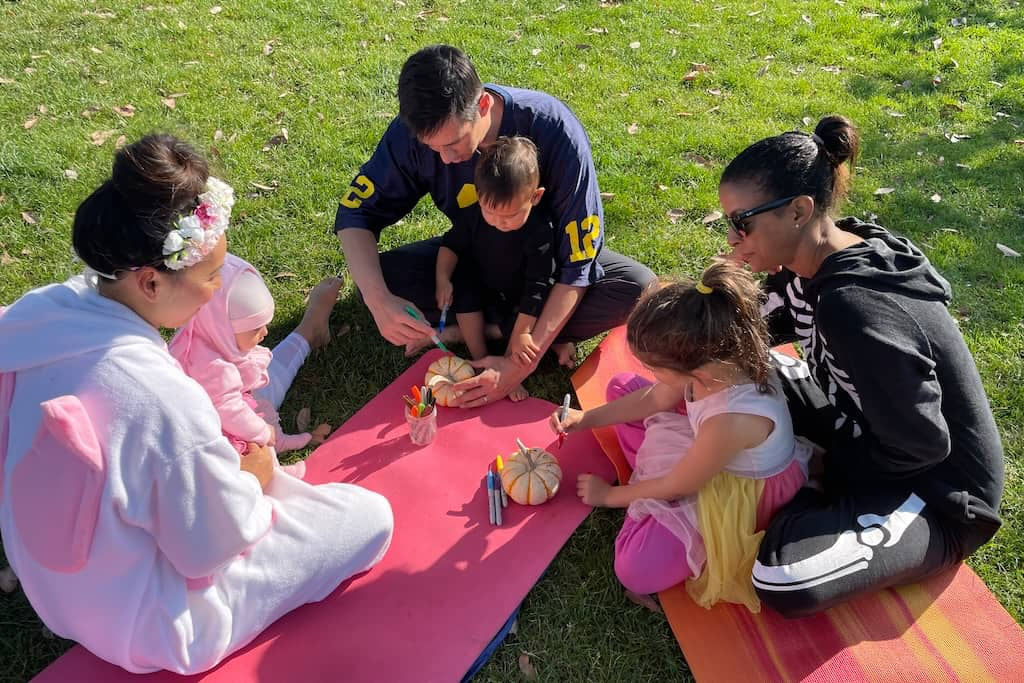Press PLAY to listen to this post.
Looking for a way to give back this holiday season while sharing quality time with your loved ones? Join us for a special Family Yoga Diaper Drive, benefiting the Homeless Prenatal Program (HPP)! This event combines the joy and connection of yoga with the power of giving, making a meaningful impact on families in need.
Why a Diaper Drive?
Diapers are essential for the health and well-being of babies, yet they remain one of the most expensive items for families living in poverty. The Homeless Prenatal Program provides vital support to expecting mothers and families experiencing homelessness, helping them achieve stability and a brighter future. By donating diapers, you are directly contributing to a healthier and happier start for these little ones.
What to Expect at the Family Yoga Diaper Drive
Bring your whole family for a fun and relaxing yoga session suitable for all ages and experience levels. Through playful poses, breathing exercises, and moments of mindfulness, you’ll bond, laugh, and feel a sense of unity while giving back to the community. This yoga class will leave you feeling centered and inspired, with hearts full of gratitude.
How to Participate
Admission to the yoga event includes a donation of diapers or baby wipes. All contributions will go directly to the Homeless Prenatal Program, ensuring that families receive the essential supplies they need. Whether you bring a box or a bag, every donation makes a difference!
The Impact of Giving
By joining the Family Yoga Diaper Drive, you’re not only promoting wellness within your own family but also uplifting other families in need. Together, we can help create a compassionate and supportive community where all parents and children have the resources they deserve.
Come stretch, breathe, and give back in a meaningful way. We can’t wait to see you there and make a positive impact together!
Press PLAY to listen to this post.
It’s intense out there! And it's going to last longer than a day. Election season often brings heightened emotions and stress, not just for adults, but for kids too. The news, debates, and intense conversations can trickle down, leaving children feeling anxious or unsettled. But how can we help them manage this stress in a healthy way?
Enter yoga. This practice offers a simple and effective way for children to cope with the emotional weight of elections or any stressful situation. Through mindful breathing, active poses, and fun activities, kids yoga teaches children how to relax, focus, and stay grounded amidst chaos.
Yoga helps reduce anxiety by promoting relaxation and self-awareness. It encourages children to tune into their bodies, release tension, and manage their emotions. A short, daily yoga routine can be a great tool for building resilience and fostering emotional balance in these turbulent times.
Managing election stress can be challenging, but there are three effective strategies to stay grounded:
- Focus on What You Can Control: Take action in meaningful ways, such as voting or supporting causes that matter to you, rather than fixating on outcomes.
- Practice Mindfulness: Engage in deep breathing, meditation, or yoga to reduce stress and stay present.
- Stay Active: Regular exercise, even a short walk, can help release tension and improve your mood.
By incorporating yoga into their routine, children can learn to navigate stress with a calm and clear mind, turning a period of uncertainty into an opportunity for emotional growth. So, when the news feels overwhelming, roll out a yoga mat and take a deep breath together—it might be just the pause both you and your child need.
By providing reassurance and offering coping tools, you can help your children navigate the emotional challenges that come with election stress. Come to yoga, we'll show you how.
Press PLAY to listen to this post.
Teaching kids about Diwali through yoga can be a fun and meaningful way to connect them with the cultural aspects of the festival while keeping them active. Diwali, the Festival of Lights, symbolizes the victory of light over darkness and good over evil.
Here’s how you can integrate Diwali into a kids' yoga class:
1. Begin with the Story of Diwali
Start the yoga session with a kid-friendly retelling of the Diwali story. Focus on the victory of good over evil, using the story of Rama and Sita and how the people lit diyas (oil lamps) to celebrate their return and banish the darkness.
- Rama's Journey: Start with Mountain Pose (Tadasana) to symbolize the beginning of Rama’s journey.
- Crossing the Forest: Use Tree Pose (Vrksasana) as Rama navigates through the forest.
- Meeting Hanuman: Move into Monkey Pose (Uttanasana), representing Hanuman’s leaps to help Rama.
- Perform Warrior Poses (Virabhadrasana II) to represent the battle between Rama and Ravana.
- Victory and Return: Conclude with Candle Pose or Boat Pose to symbolize the lighting of lamps as Rama returns victorious.
2. Mindfulness Through Light and Gratitude
Diwali is the Festival of Lights, so focus on bringing light into your yoga session:
- "Shining Star Pose": Have kids come into Star Pose (wide-legged stance with arms out) and encourage them to shine bright like a star or a diya, imagining they’re lighting up the world with kindness.
Diwali is a time for reflection, gratitude, and renewal. Introduce mindfulness practices that align with these themes:
- "Pass the Light": Sit the children in a circle, and have them pass a small object that represents a diya (a glowing ball, candle, or light). As each child passes the "light," they say something they’re grateful for.
3. End with Relaxation and Reflection
Finish the class with a peaceful relaxation session:
- Guided Relaxation: Lead the kids through a relaxation where they imagine themselves walking through a beautifully lit street filled with glowing lamps. Encourage them to feel peaceful, safe, and happy.
By weaving the cultural themes of Diwali into a yoga session, you can make the class fun, meaningful, and memorable for children. They'll not only learn about yoga but also connect with the values of light, gratitude, and kindness, which are central to the Diwali celebration.
You can learn more kids yoga themes in our training accredited by Yoga Alliance. Join the waitlist and be the first to know when enrollment opens in January each year.
Press PLAY to listen to this post.
Making kids' yoga fun for Halloween can transform the practice into a playful and engaging experience. You can incorporate Halloween themes, games, and costumes while still maintaining the core benefits of yoga. Here are some ideas to create a spooky, fun-filled yoga session for kids:
1. Use Halloween-Themed Stories and Songs
- Spooky Yoga Storytime: Create a simple Halloween story where kids act out parts of the story through yoga poses. For example, “We’re going to a haunted house. First, we pass through the pumpkin patch (Pumpkin Pose), then we fly over on our broomsticks (Witch Pose), and finally, we meet a friendly ghost (Ghost Pose).”
- Halloween Music: Play fun, not-too-scary Halloween music during the class (like "Monster Mash" or "Ghostbusters"). This adds excitement and sets the Halloween vibe.
2. Incorporate Costumes
- Dress-Up Yoga: Encourage kids to wear their Halloween costumes to the yoga session, but make sure they are comfortable enough to move around. You can also create simple accessories like witch hats or bat wings for kids to wear during specific poses.
- Pose as Your Favorite Character: Ask the kids to take turns posing like their favorite Halloween character (witches, skeletons, vampires) and guide them through a related yoga pose.
3. Halloween Yoga Games
- "Spooky Freeze Dance": Play Halloween music and let the kids dance around the room. When the music stops, they have to freeze in a yoga pose (e.g., zombie, bat, or black cat).
- "Trick or Treat Yoga": Fill a Halloween bucket with pieces of paper, each listing a different yoga pose. The kids take turns picking a paper from the bucket, and whatever they pick, they must lead the group in that pose. You can call it a "treat" when they get to lead a fun pose, or a "trick" if it’s a challenge!
4. Incorporate Breathing Exercises
- "Pumpkin Breaths": Have the kids sit in a cross-legged position, place their hands on their bellies, and take deep breaths, inflating their bellies like a big pumpkin. On the exhale, they can make a soft "whooshing" wind sound like a spooky breeze.
- "Ghost Breaths": Encourage slow, deep inhales and, on the exhale, let the kids make a soft "Ooooo" ghost sound as they release the breath.
5. Create a Halloween-Themed Relaxation
- "Spider Web Relaxation": At the end of class, guide the kids through a relaxation where they lie still as if caught in a soft spider web. You can describe a gentle breeze blowing and calming them as they rest in the web (Savasana).
- "Magic Potion Relaxation": Tell the kids to imagine they’re drinking a magic potion that helps them relax their bodies. Walk them through relaxing each part of their body, starting with their toes all the way up to their heads.
These activities will help create a fun, playful, and engaging atmosphere while still promoting the benefits of yoga. Halloween-themed yoga can foster creativity and imagination, making the practice more enjoyable for kids during the spooky season!
Join our Halloween IYK® Family Event on Sunday, October 27 at 10am. We’ll see you then!




